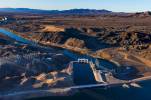COMMENTARY: Trump administration proposal would boost Nevada road projects
The Nevada Department of Transportation plans to complete more than 60 construction projects this year, including much-needed improvements to the state’s bridges and highways. Projects such as these often get needlessly delayed. The Trump administration is working hard to change that.
The White House recently proposed streamlining how federal agencies implement the National Environmental Policy Act, a 50-year-old law responsible for much of the red tape that plagues infrastructure projects.
These changes will save substantial taxpayer funds and pave the way for a host of new jobs.
The act requires government agencies to evaluate the potential environmental impact of federally funded public works projects. Local, state, and federal officials all need to comply with the act before breaking ground on a new airport or making improvements to a highway. NDOT will need to secure permits under the law before moving forward with most of its planned roadway improvements.
In its early days, the act was an effective environmental regulation. But the law hasn’t been updated since the 1980s. Since then, the NEPA approval process has grown long and complicated. Anyone who wants a NEPA permit must deal with various federal agencies, each with different approval processes.
Today, the average environmental impact statement — just one of the documents required by the act — runs 600 pages. It took three times longer to complete a NEPA assessment for transportation projects in 2011 as it did in the 1970s. It takes even longer today.
These regulatory hurdles keep our state in disrepair. In its most recent report card, the American Society of Civil Engineers gave Nevada’s infrastructure a C. The society estimates that more than 150 of our state’s dams are “high-hazard potential,” which means their failure could put lives at risk.
The act also makes life more difficult for anyone with a car. Nearly 2 percent of Nevada’s bridges are structurally deficient, and 14 percent of our roads are in poor condition. On average, each driver pays more than $530 per year in repairs, thanks to our decrepit roads.
I have some personal experience with NEPA delays. The first portion of Interstate 11 opened in my district last year. Clark County cheered the first phase of the new highway, which will eventually connect Phoenix and Las Vegas. Upon completion, I-11 will give Nevadans faster access to Arizona’s shipping ports, create 250,000 permanent jobs and add more than $20 billion to the U.S. economy.
But redundant NEPA reviews have slowed I-11 construction. As of late last year, I-11 stretched just 15 miles. Completing I-11’s NEPA review in Nevada is projected to take three years and cost taxpayers $5 million. And as long as construction stalls, Nevadans won’t have access to the vast economic benefits the highway will bring.
My favorite benchmark for public projects is the Alaskan highway. In 1943, we were able to build 1,600 miles of highway through the wilderness in eight months. We surveyed the route, cleared it, prepared it, overcame permafrost and installed the road itself. And we did it without devastating the pristine environment. Now, 77 years later, government red tape can delay such permitting processes by up to 25 years.
Updating NEPA will give a boost to I-11 and other infrastructure projects. The White House’s proposal would require federal assessors to wrap up reviews in two years or less. A single federal agency would take the lead for each review to cut down on redundancy. These changes would streamline the act’s review process without reducing environmental standards.
For too long, NEPA has hindered Nevada’s economy and infrastructure alike. Updating this law will protect the environment without delaying much-needed projects. This will help everyone in the state have smoother commutes.
— Chris Edwards, a Republican, represents District 19 in the Nevada Assembly.





























